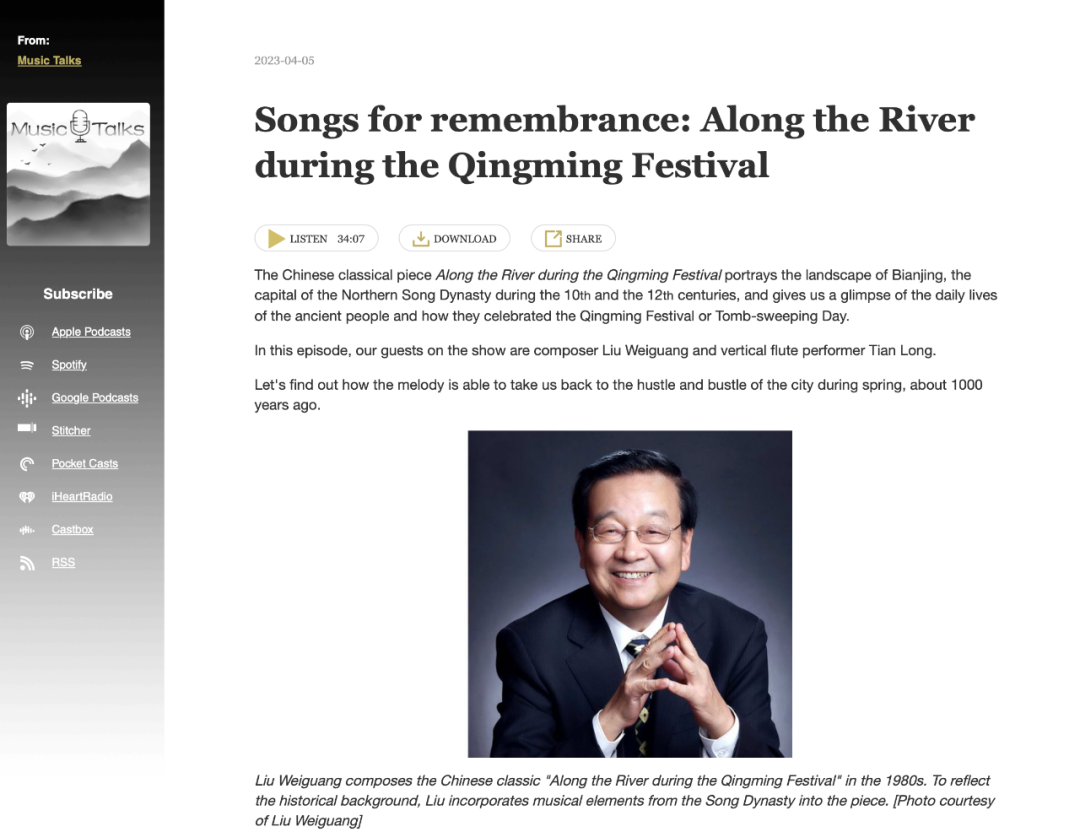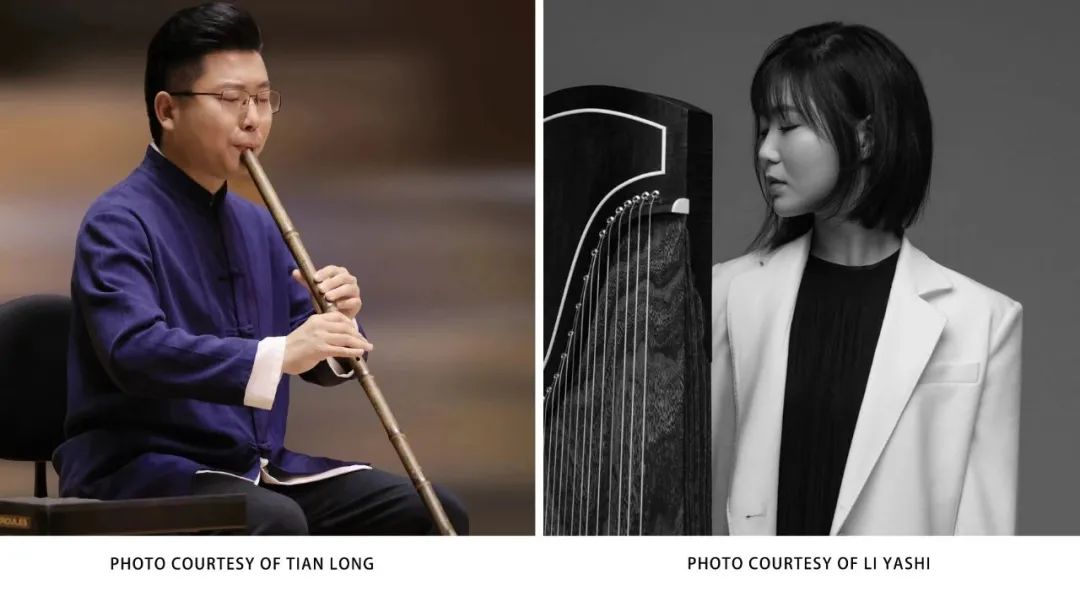Songs for Remembrance: Along the River during the Qingming Festival

The artwork "Along the River during the Qingming Festival" features a panoramic view of Bianjing, the capital of the Northern Song Dynasty during the 10th and the 12th centuries, and the activities of people from all walks of life during the Qingming Festival. [Photo from CFP]
Anchor:
Music Talks in different ways. Hi there, I am Tony Reid.
The piece you are hearing now is titled Along the River during the Qingming Festival, played with the guzheng and the xiao, translated respectively as the 21-stringed zither and the vertical flute.
It portrays the landscape of Bianjing, the capital of the Northern Song Dynasty during the 10th and the 12th centuries, and gives us a glimpse of the daily lives of the ancient people and how they celebrated the Qingming Festival.
For those that are wondering what the festival is about, it is a day when Chinese people visit and neaten their ancestral tombs in a bid to commemorate their deceased loved ones.
In this episode, our guests on the show are composer Liu Weiguang and flutist Tian Long. The composer will give us some insight about the creative process behind the music and the instrumentalist will share with us the experience from a performer’s perspective.
Moreover, we will also get a glimpse of the traditions of the festival.
But first, let’s continue with the song Along the River during the Qingming Festival. While its melody takes us back to the hustle and bustle of Bianjing during spring, 1000 years ago.

Anchor:
That was the first movement of the suite Along the River during the Qingming Festival, which highlights how the ancients paid visits to their ancestors’ graves, expressing respect and honor, while sharing recent family matters with the deceased.
The musical suite was composed in 1985 by Liu Weiguang, which drew inspiration from a well-known ancient hand scroll with the same name. This scroll apparently featured a panoramic view of Bianjing, and the activities of people from all walks of life during the Qingming Festival.
The scroll is divided into three sections, about 5 meters in length and just under a quarter of a meter in height.
On it, includes the suburb of the ancient city, daily practices of the people living near Bianhe River, and even displays the allure of the city center, such as shops, dining and entertainment.
The composer Liu Weiguang shares with us why he wrote a song inspired by such a stunning painting.

(Act 1: Liu Weiguang)
“In the 1980s, I was invited to write music for a documentary series titled The Forbidden City, and I selected a couple of topics that I was interested in. The artwork Along the River during the Qingming Festival caught my attention. Although I wasn’t quite familiar with it, I felt it was able to trigger inspiration due to its huge amount of details. To spark my creativity, I got very close to the scroll to observe the intricate details of the authentic panoramas collected in the Palace Museum, wearing white protective clothes and gloves. I also read a lot of related historical documents. Then, I decided to write a suite consisting of five segments to reflect the masterpiece, including The Qingming Festival, Spring Outing I and II, A Difficult Voyage and The Era of Prosperity.”
Anchor:
Now, let’s move on to the second movement of the suite, titled Spring Outing I.
Anchor:
That was the second movement of the suite Along the River during the Qingming Festival, titled Spring Outing I.
The next segment of the suite is Spring Outing II.
Liu says both segments reflect the traditional customs of the Qingming Festival.
(Act 2: Liu Weiguang)
“The Qingming Festival is not only a time for people to pay tribute to their deceased loved ones, but also a pleasant time to go out and enjoy the weather, which is shown in the historical painting. For example, there’s imagery of several children flying kites, among other things. I wrote two segments about the spring outing, with the first one being more peaceful and classical, and the second relatively more energetic.”
Anchor:
That was the third movement of the suite Along the River during the Qingming Festival, titled Spring Outing II.
As we mentioned earlier, the suite was inspired by the ancient scroll. So the composer says he hopes that our listeners are able to feel the elegance, sophistication and the sentiment of dedication conveyed in the song as he incorporated musical elements from long ago.
(Act 3: Liu Weiguang)
“We believe our music is supposed to be able to reflect the historical background, so I spent quite some time to study the music passed down from the Song Dynasty. Jiang Baishi was a celebrated musician from that era, and his songs and lyrics were reserved in his collections. However, the ancient Chinese sheet music was rather ambiguous, as it wasn’t written in notes, but instead with Chinese characters and symbols, indicating playing techniques and descripting at what part of the string the player should pluck or press. Hence, I could only have a general perspective about how the music might sound like. Ultimately, I selected one small phrase from Jiang’s songs as my motif, and made many variations based on it. I also studied an ancient Chinese opera and several traditional musical styles, including one of the oldest operas of the Han Chinese called Kunqu opera, Chaozhou music that has over 1000 years of history, and a musical performance genre of the southern region of Fujian Province called Nanyin. I believe these art treasures have retained some features of Song music to some extent.”
Anchor:
The next segment of the suite is titled A Difficult Voyage, depicting several boatmen working together to row the boat against the river current.
Anchor:
That was the fourth movement of the suite Along the River during the Qingming Festival, titled A Difficult Voyage.
The widespread version of the work is played by the Chinese harp, known as the konghou and the vertical flute called the xiao. This harp was originally introduced to China through the Ancient Silk Road over 2000 years ago and vanished in the late 14th century. In the 1980s, musicians put a lot of effort into replicating the instrument in accordance with historical documents and illustrations found within the Dunhuang murals, so the composer Liu Weiguang decided to use the harp in his song to enhance the general awareness of it.
Now, the rendition of the suite that we present to you today is played with the 21-stringed zither and the vertical flute. The zither, referred to as the guzheng in Chinese, is renowned for its melodic tonality, while the flute, AKA the xiao, is famous for its melancholic ambience.
(Act 4: Liu Weiguang)
“The rendition played with the Chinese harp and the vertical flute has become a classic in Chinese music over the past four decades. Over the years, several composers and performers rearranged the suite so that it could be suitable for more instruments to play. The 21-stringed zither has some similarities with the konghou, as they are both plucked-stringed instruments. The zither is more popular among the public than the konghou, so I appreciated the effort of those who rearranged it as they made a breakthrough in promoting the piece to a larger number of audience members.”
Anchor:
Next up, let’s hear the last segment of the suite, titled An Era of Prosperity, a reflection of the Song Dynasty’s wealth throughout Chinese history.
Anchor:
Tian Long is the flutist or the xiao performer of the piece. He says his inner world has changed significantly when performing it after so many years of practice.

(Act 5: Tian Long)
“I first heard the piece Along the River during the Qingming Festival on a cassette tape when I was in middle school. When I practiced it as a student, I was able to picture the painting in my mind. When I recorded this rendition of the suite in 2020, I realized I imagined I was as one of the figures illustrated in the masterpiece, feeling the story and emotion attached to it.
“I decided to use the zither in this rendition, as the number of this instrument’s learners is the largest compared to that of students learning others, so more people would be able to play the song if they want to. A couple of famed composers and one instrumentalist assisted me rearrange the work. The zither is able to play five notes per octave, while the harp is able to play seven, so they mainly adapted appropriate playing techniques of the zither to make up the fact that it couldn’t produce the remaining sounds.”
Anchor:
That was the last movement of the suite Along the River during the Qingming Festival, An Era of Prosperity.
The Qingming Festival, also known as Tomb-Sweeping Day, has over 2500 years of history, and this year it falls on April 5th on the Gregorian calendar.
In addition to visiting graves, cleaning the site, and making offerings, people also partake in a multitude of activities during this time, such as spring blossom viewing, hiking, flying kites and bike riding. Another tradition is to wear or hang willow twigs on the door since the pronunciation of “willow” in Chinese resembles the word, “stay”.
The Qingming Festival is also one of the 24 solar terms in China, which is a signal that the weather is getting warmer and there is a higher chance of rain.
The piece you are hearing now is titled A Rainy Day by flutist Tian Long. Let’s hear it.
(Act 6: Tian Long)(19'22''-26'37'' )
“A Rainy Day was inspired by a story included in a classic of a famed ancient philosopher called Liezi. The story is about a fisherman who often enjoyed the company of hundreds of sea gulls to go with him when went fishing in the sea. The birds were not afraid of him and often sat on his shoulders. When the man’s father asked his son to capture some sea gulls for him one day, he reluctantly agreed. However, when he went fishing again and extended his arm for the sea birds to land, none of them came down but kept flying high in the sky, sensing his intention.”
Anchor:
That was A Rainy Day.
With that, we come to the end this episode of Music Talks.
We hope the tracks we shared will connect and resonate with our listeners during this special time of the year.
To wrap up the show, we have Tian Long’s The Zhongnan Mountain(26'37'' ), inspired by Wang Wei’s ancient poem with the same name, which depicts this northwest mountain’s picturesque view riddled with clouds.
For more from us, be sure to find us on Apple Podcasts, Spotify, Stitcher or wherever you find your favorite podcasts.
We hope to see you next time. Bye for now.

中国国际电视台(英文名称:China Global Television Network,英文简称:CGTN,中文别称:中国环球电视网),是中央广播电视总台所属面向全球播出的新闻国际传播机构 。
